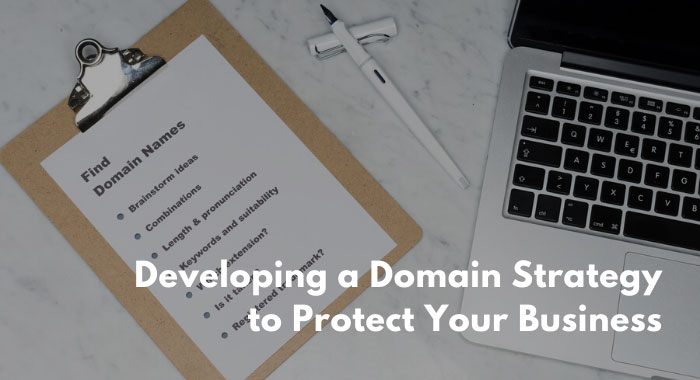Businesses face many different kinds of threats from many different places. As a business owner, you have to worry about things like someone hacking into your private computers, someone breaking into your building, or someone working to steal your customers. Protecting your business is a key responsibility for any business owner and one that they shouldn't take lightly.
One area that your business needs to be protected, that is sometimes overlooked, is with your domain name. When you create a website for your business, you will typically register a domain name for it, something like "businessname.com". If your business grows popular enough, you may have people trying to infringe on that domain name, or create ones similar to it so they can pretend to be you. This is why it's important to develop a domain strategy that will protect your business as early as possible.

Did You Know?
- Brand Protection: 85% of businesses consider domain name protection as a top priority for safeguarding their brand identity online.
- Cybersquatting Issues: Over 75% of trademark disputes are related to domain cybersquatting.
- Revenue Impact: Companies lose an average of 10% in revenue due to domain-related fraud.
- Customer Trust: 90% of consumers feel safer interacting with a business that has a clear and professional domain name.
- SEO Importance: 70% of SEO experts believe that a relevant domain name boosts search engine rankings.
- Domain Extensions: There are over 1,500 top-level domain (TLD) extensions available, with .com domains making up 46.5% of all global websites.
- Brand Recall: 60% of customers are more likely to remember a brand with a straightforward and relevant domain name.
Trademark Your Business
The first step in any domain strategy should be to trademark your business. This process can often be done without a lawyer and takes roughly 90 minutes. All you need to do is search the database to ensure no one else has a trademark on your name, and then complete the online application. Here are the steps to take;
Find Out Whether You Can Trademark Your Business Or Not
First, make sure your business name or logo isn't stepping on anyone's toes. Here's how to start:
- Conduct a Thorough Search: Use the United States Patent and Trademark Office (USPTO) website to search for existing trademarks that might be similar to yours. It's not just about finding an identical match; look for ones that could be confusingly similar, too.
- Consider the Scope: Think about what goods or services your trademark will cover. Trademarks are categorized by classes, and your application needs to specify this. For instance, a clothing brand and a software company might have the same name but fall into different classes.
- Evaluate the Strength: Trademarks can range from generic terms, which are not trademarkable, to fanciful or arbitrary marks, which are the strongest. Your trademark should ideally be unique and distinctive to stand out and be protectable.
Prepare Your Application
Once you've done your homework, it's time to get your application ready. Here's what you need to do:
- Identify Your Mark: Decide if you're registering a name, logo, or both. Each type of trademark may require different preparations. For a logo, you'll need a clear image file.
- Detail Your Use: You must specify whether you are already using the trademark in commerce or intend to use it in the future. If you're already using it, you'll need to provide examples of its use, like advertisements or product packaging.
- Fill Out the Application: The USPTO's online system, TEAS, is where you'll submit your application. You'll need to provide detailed information about yourself or your business, your trademark, and how you plan to use it.
CyberCash Wonderland

"...But it's my name! Austin Texas is my name!"
"Well, Austin Texas Delicious Coffee... First of all, your name is also a geographical location. Second of all, "Delicious" is a descriptive of the quality. For that reason, Austin, the trademark office wouldn't likely grant protection for those elements."
Submit and Monitor
After your application is in, there's still work to do:
- Pay the Fees: Trademark applications come with a fee, varying depending on the filing basis and the number of classes you're applying for. Be prepared to pay when you submit.
- Keep an Eye Out: The USPTO will assign an examining attorney to review your application. They might have questions or require clarifications, so watch your email closely.
- Respond Promptly: If the USPTO sends an Office Action, which is a formal communication that might request more information or raise issues with your application, respond by the deadline. Failure to do so can result in your application being abandoned.
After Approval
Getting your trademark approved is a big win, but there's a bit more to do:
- Use the Mark: Now that you have your trademark, use it consistently. This helps in building your brand and maintaining the strength of your trademark.
- Monitor for Infringement: Keep an eye on the market for anyone who might be using your trademark or something very similar. It's up to you to enforce your trademark rights.
- Maintain Your Registration: Trademarks can last indefinitely, but you need to file specific documents and pay fees at regular intervals to keep your registration active. This includes showing that you're still using the trademark in commerce.
Register the Most Popular Domain Name Extensions
Next, you should look to register your domain with all of the most popular domain name extensions.
For example, let's say your current website is "JohnsBrewery.com". As part of your domain name strategy, you should also register "JohnsBrewery.net" and "JohnsBrewery.co". It's a good idea to do this even if your name is trademarked, because it may prevent you from having to take legal action down the line.
In addition, sometimes people simply forget what domain name they are supposed to be visiting. If someone types in "JohnsBrewery.net" by accident, you don't want to lose out on that customer. Registering your domain name with some of the more popular extensions can help you to gain more customers in the long run.
Did You Know?
- Phishing Attacks: Phishing attacks using fake domain names have increased by 250% in the past year.
- International Protection: Only 20% of small businesses register their domain name in multiple countries, risking international brand dilution.
- Digital Asset Value: Premium domain names can sell for millions, with Voice.com selling for $30 million in 2019, the highest on record.
- Renewal Rates: The average domain renewal rate is around 85%, indicating the importance of domains to businesses.
- Mobile Optimization: 80% of top-ranking domains are mobile-friendly, emphasizing the importance of a comprehensive digital strategy.
- Social Media Influence: 65% of domain strategies include matching social media handles to maintain brand consistency.
- Domain Age: Older domains, particularly those over 10 years, are trusted by 75% of internet users over newer ones.
Register Related Names
The next part of your domain name strategy should be to register names that are similar to your own. This will not only help if your customers make a simple typo when trying to visit your site, but it will prevent others from easily pretending to be you.
For example, if you're "JohnsBrewery.com", it's not a bad idea to also register "JonsBrewery.com", "JohnBrewery.com" and "JohnsBrewers.com". You can see how someone could type in one of those web addresses and think they are visiting your site.
By now you can likely see a small problem with developing a domain strategy - it's expensive. Paying for each possible domain name that is similar to your own will add up over time. Some of the domain names you want may already be registered as well, meaning you'd have to buy a taken domain name.
This is why you'll want to search for the cheapest domain names when registering. Find a domain name provider that charges as little as possible, or will sell domain names in bulk. Since you aren't putting anything on these websites, you don't have to worry too much about the hosting capabilities or customer service quality from the domain name provider - all you need is an affordable price.
Set Up Domain Forwarding

Once you have all your domain names, you'll need to set up domain forwarding. What this will do is automatically forward someone onto your main domain name if they accidentally visit one of the incorrect ones.
When you buy a domain, the place you bought it from usually lets you redirect it to another website. This means if someone goes to your domain, they can be automatically sent to a different website you choose.
To set this up, you typically use a tool or option provided by your domain provider.
- First, you log into your account where your domain is registered.
- Look for a section called "Domain Management," "Domain Settings," or something similar.
- Inside, you should find an option for "Forwarding," "Domain Forwarding," or "Redirect."
- Click on this option, and you'll be asked to enter the website address you want to forward your domain to.
- After entering the website address, you might have to choose if you want the forwarding to be permanent or temporary.
- Some providers also let you decide if you want the address bar in the browser to show your domain or the destination domain.
- Once you've made your choices, save your settings.
The exact steps might vary a bit depending on who you bought your domain from. It might take a little while for the changes to take effect, sometimes up to 48 hours. If you're not sure how to do it, most providers offer guides or customer support to help you.
Did You Know?
- Investment in Domains: Businesses spend an average of 10% of their marketing budget on domain management and protection.
- Email Security: 50% of businesses have experienced email spoofing due to similar domain names.
- Direct Navigation: 68% of internet users still engage in direct navigation, typing the domain directly into the browser.
- Secondary Market: 20% of small to medium-sized enterprises acquire their domain through the secondary market.
- Legal Costs: Companies can spend up to $200,000 on legal fees to combat domain squatting issues.
- Market Presence: A comprehensive domain strategy can increase a brand’s market presence by up to 40%.
Monitor Your Brand Online
Finally, the last thing you need to do is consistently monitor your brand online. If someone tries to start posing as you using a domain name you forgot to register, you'll want to know this right away.
One simple way to do this is by setting up a Google Alert. With this system, you can type in some keywords, and if Google notices them popping up anywhere else, they will send you an alert to your email. You can then create a keyword list containing variations of your business name, or even your slogan.
The other thing to do is occasionally perform a manual search online. Some ways you can do this are:
- Copy some of your content in a search engine and see if it appears on any other website.
- Search social media for accounts similar to your brand name
- Do a reverse image search for your logo or any unique pictures you have on your website
Get Started with Your Domain Strategy
Implementing a comprehensive domain strategy takes time and contributes significantly to your website costs. This is why it's important to start planning ahead now so that you can begin protecting your business sooner rather than later. Hopefully, this guide was able to provide you with a blueprint for how you can protect your business online and you won't have to worry about anyone infringing upon your business in the future.
